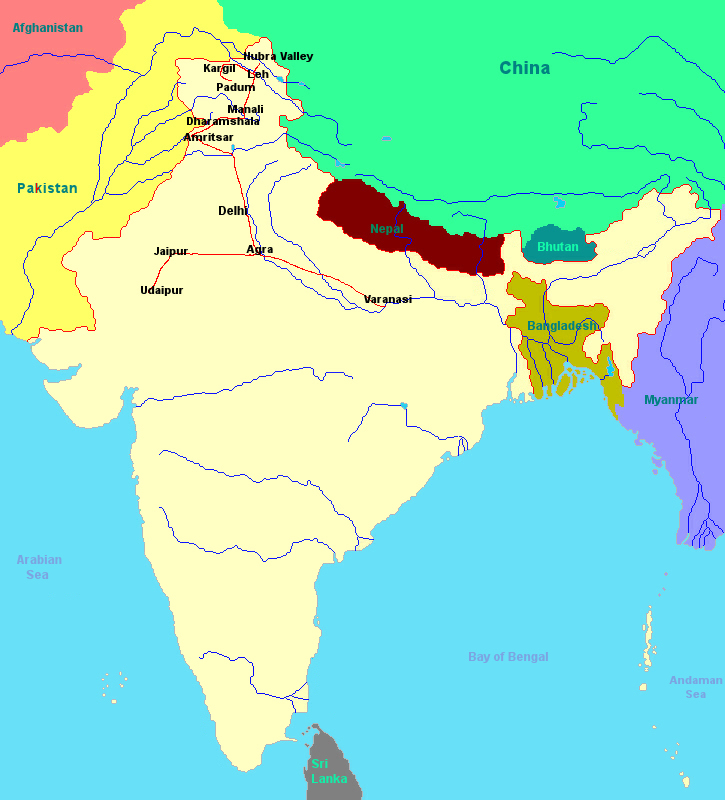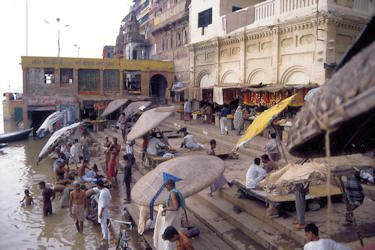India

Historie
The earliest known human remains in South Asia date to about 30.000 years ago. Nearly contemporaneous human rock art sites have been found in
many parts of the Indian subcontinent, including at the Bhimbetka Rock Shelters in Madhya Pradesh.
After 6500 BC, evidence for domestication of food crops and animals, construction of permanent structures, and storage of agricultural surplus,
appeared in Mehrgarh and other sites in what is now Balochistan. These gradually developed into the Indus Valley Civilisation,
the first urban culture in South Asia, which flourished during 2500–1900 BC in what is now Pakistan and western India.
During the period 2000–500 BC, many regions of the subcontinent transitioned from the Chalcolithic cultures to the Iron Age ones.
The Vedas, the oldest scriptures associated with Hinduism, were composed during this period, and historians have analysed these
to posit a Vedic culture in the Punjab region and the upper Gangetic Plain.
The caste system, which created a hierarchy of priests, warriors, and free peasants, but which excluded indigenous peoples by labeling their
occupations impure, arose during this period.
In the late Vedic period, around the 6th century BC, the small states and chiefdoms of the Ganges Plain and the north-western regions had
consolidated into 16 major oligarchies and monarchies that were known as the Mahajanapadas.
The emerging urbanisation gave rise to non-Vedic religious movements, two of which became independent religions. Jainism came into prominence
during the life of its exemplar, Mahavira. Buddhism, based on the teachings of Gautama Buddha, attracted followers from all social
classes excepting the middle class; chronicling the life of the Buddha was central to the beginnings of recorded history in India.
At the 3rd century BC, the kingdom of Magadha had annexed or reduced other states to emerge as the Mauryan Empire. The Mauryan kings are
known as much for their empire-building and determined management of public life as for Ashoka his renunciation of militarism and far-flung
advocacy of the Buddhist dhamma.
By the 4th and 5th centuries AD, the Gupta Empire had created in the greater Ganges Plain a complex system of administration and taxation
that became a model for later Indian kingdoms.
The Indian early medieval age, 600 AD to 1200 AD, is defined by regional kingdoms and cultural diversity. When Harsha of Kannauj, who ruled
much of the Indo-Gangetic Plain from 606 to 647 AD, attempted to expand southwards, he was defeated by the Chalukya ruler of the Deccan.
When his successor attempted to expand eastwards, he was defeated by the Pala king of Bengal. When the Chalukyas attempted to expand
southwards, they were defeated by the Pallavas from farther south, who in turn were opposed by the Pandyas and the Cholas
from still farther south.
No ruler of this period was able to create an empire and consistently control lands much beyond his core region.
After the 10th century, Muslim Central Asian nomadic clans, using swift-horse cavalry and raising vast armies united by ethnicity and religion,
repeatedly overran South Asia's north-western plains, leading eventually to the establishment of the Islamic Delhi Sultanate (1206–1526).
By repeatedly repulsing Mongol raiders in the 13th century, the sultanate saved India from the devastation visited on West and Central Asia, setting
the scene for centuries of migration of fleeing soldiers, learned men, mystics, traders, artists, and artisans from that region into the
subcontinent, thereby creating a syncretic Indo-Islamic culture in the north.
The sultanate's raiding and weakening of the regional kingdoms of South India paved the way for the indigenous Vijayanagara Empire
(1336-1646).
In the early 16th century, northern India, being then under mainly Muslim rulers, fell again to the superior mobility and firepower of a new
generation of Central Asian warriors. The resulting Mughal Empire (1526-1857) did not stamp out the local societies it came to rule, but
rather balanced and pacified them through new administrative practices.
The reign of Shah Jahan (1628–1658) represented the height of Mughal architecture, with famous monuments such as the Taj Mahal,
Moti Masjid (Agra Fort), Red Fort and the Jama Masjid being constructed during his reign.
By the early 18th century, with the lines between commercial and political dominance being increasingly blurred, a number of European trading
companies, including the English East India Company, had established coastal outposts.
The East India Company's control of the seas, greater resources, and more advanced military training and technology led it to increasingly flex
its military muscle and caused it to become attractive to a portion of the Indian elite; these factors were crucial in allowing the company to
gain control over the Bengal region by 1765 and sideline the other European companies.
Its further access to the riches of Bengal and the subsequent increased strength and size of its army enabled it to annex or subdue most of India
by the 1820s.
The country became an independent nation within the British Commonwealth on 15 August 1947. Concurrently the Muslim-majority northwest and east
of British India was separated into the Dominion of Pakistan, by the partition of India. The partition led to a population transfer of more
than 10 million people between India and Pakistan and the death of about one million people.
Indian National Congress leader Jawaharlal Nehru became the first Prime Minister of India, but the leader most associated with the independence
struggle, Mahatma Gandhi, accepted no office. The new constitution of 1950 made India a democratic country.
The nation faced religious violence, casteism, naxalism, terrorism and regional separatist insurgencies, especially in Jammu and Kashmir and
northeastern India. India has unresolved territorial disputes with China, which in 1962 escalated into the Sino-Indian War, and with
Pakistan, which resulted in wars in 1947, 1965, 1971 and 1999.
From the 1950s to the 1980s, India followed socialist-inspired policies. The economy was influenced by extensive regulation, protectionism and
public ownership, leading to pervasive corruption and slow economic growth.
Beginning in 1991, neoliberal economic reforms have transformed India into the third largest and one of the fastest-growing economies in the world,
though corruption remains a pervasive problem.
Today, India is a major world power with a prominent voice in global affairs and is seeking a permanent seat in the United Nations Security Council.
My first visit to India was in oktober 1992
These are the places I have seen on that trip
Delhi
Agra
Jaipur
Udaipur
Varanasi
My second trip to India was in august 2019
These are the places I have seen on that trip
Delhi
Amritsar
Dharamshala
Manali
Manali-Leh Highway
Leh
Nubra Valley
Leh-Kargil route
Kargil
Kargil - Padum route
Padum
Please let me know when you're having questions.
i would be pleased to help you.
Things to do and other tips
